PR-0552UK Primary Science - Book 2
You also want an ePaper? Increase the reach of your titles
YUMPU automatically turns print PDFs into web optimized ePapers that Google loves.
Differentiating activities<br />
Meeting the needs of pupils<br />
The activities in the <strong>Primary</strong> <strong>Science</strong> series have been designed so<br />
that they can be followed precisely or adapted by teachers. This<br />
flexibility allows teachers the opportunity to differentiate lessons<br />
and copymasters to meet the needs of pupils with varying abilities<br />
and special needs.<br />
The activities and copymasters in <strong>Primary</strong> <strong>Science</strong> can be<br />
differentiated by incorporating the following suggestions into<br />
teacher planning and programming.<br />
To meet the special needs of pupils who have English as a<br />
second language, plan a time on a day before the science unit<br />
begins to introduce keywords and concepts. Having other adult<br />
support would be ideal as the group can work in a quiet area away<br />
from the classroom. Keywords can be enlarged and discussed.<br />
By explaining each word and showing objects or pictures, the<br />
pupils will be able to make connections between the word and<br />
the object. For ESL pupils, being immersed in the language before<br />
a topic begins gives them an advantage, especially during the<br />
teacher discussion part of the lesson, when most teachers tend<br />
to speak quite quickly.<br />
Before the unit, allow time for the pupils to look at nonfiction or<br />
fiction books about the topic. These will give pupils the opportunity<br />
to learn by reading books with clear and simple language. Pupils<br />
with reading problems will be able to immerse themselves before<br />
the unit begins. If other adult help is available, group pupils with<br />
low literacy levels together. The assisting teacher or parent will<br />
be able to read instructions, labels and the questions on the<br />
copymasters to the pupils and guide them through experiments.<br />
If other adults are not available, mixed ability groups will allow<br />
ESL pupils and pupils with low literacy levels to observe and be<br />
guided by other pupils. Teachers can produce activity sheets so<br />
pupils can become familiar with the terminology and content of<br />
a science unit before it is started with the whole class. Include<br />
activities such as missing letters, matching pictures to words and<br />
finding definitions. Diagrams from the unit can also be simplified<br />
on these worksheets. Any time that can be spent with the pupils<br />
preparing them for the topic ahead will enable them to feel more<br />
familiar and confident with the materials, skills and concepts.<br />
Pupils who seem to race through the activities and copymasters<br />
and who understand the content very quickly, can be challenged<br />
by looking at the topic in greater depth (rather than being given<br />
more of the same). They can go beyond the facts and begin to<br />
analyse, create their own hypothesis and conduct research related<br />
to strands of the topics that interest them.<br />
By meeting the needs of individual pupils, allowing the pupils to<br />
learn collaboratively and by having very clear instructions and<br />
expectations, science lessons should run smoothly. If a pupil<br />
prevents others from learning or if he or she could potentially<br />
cause harm to another pupil, he or she should be removed from<br />
the classroom. Organise a buddy system with another colleague,<br />
where pupils are taken without explanation. Pupil–teacher<br />
conferences can occur after the lesson.<br />
Display ideas for the science classroom<br />
By having a variety of means by which they can record and<br />
present their findings, more pupils will be given the opportunity to<br />
succeed. Displays and records can communicate and share ideas,<br />
provide the stimuli for creative work, show interrelationships, and<br />
develop the ability to interpret information in different forms or<br />
accurately record observations and fine details. Some methods<br />
by which pupils can display or record their science work are<br />
shown below.<br />
Viewing Sample<br />
Type of display/record Examples Could follow<br />
charts pictures, tables, graphs experiments<br />
creative writing poems, narratives sensory experiences<br />
models/machines recycled materials, wood, clay experiments<br />
sketches observations or interpretations excursions<br />
diagrams plants, animals environmental studies<br />
tables classification, tallies observations over time<br />
collections rocks, plants, animals comparing/classifying activities<br />
tally sheets events, counting objects experiments, counting<br />
dioramas environments, landforms, systems environmental studies<br />
graphs measurement, number, change change over time, measuring activities<br />
maps/plans streets, buildings, environmental sites excursions<br />
diaries observations, drawings change or progress/deterioration over time<br />
video or audio recordings sounds, spoken reports, descriptions excursions, environmental studies<br />
interviews role-playing, guests guest speaker presentation<br />
mobiles collected objects, words comparing/classifying activities<br />
posters/banners environmental issues environmental studies<br />
pupil books individual research any topic<br />
www.prim-ed.com ~ <strong>PR</strong>IMARY SCIENCE ~ Prim-Ed Publishing<br />
v

















